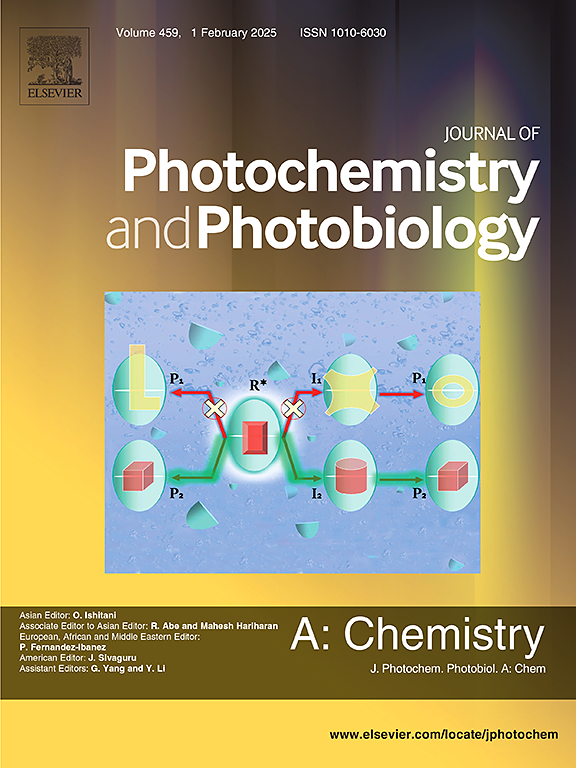Time-tunable white light emission in waterborne colloidal smart polymer-MXene quantum dots for high-level anticounterfeiting
IF 4.1
3区 化学
Q2 CHEMISTRY, PHYSICAL
Journal of Photochemistry and Photobiology A-chemistry
Pub Date : 2025-04-20
DOI:10.1016/j.jphotochem.2025.116446
引用次数: 0
Abstract
The aqueous dispersion of MXene quantum dots (MQDs) is a precursor for white light-emitting colloidal polymer particles. This study presents a method of synthesizing Ti3C2Tx MQDs with a uniform size distribution and customizable optical properties. The MQDs—doped with ethylenediamine, sulfuric acid, and thiourea that have nitrogen, sulfur, and both of nitrogen and sulfur groups, respectively—exhibit a high-intensity emission across the blue to red spectra. The incorporation of spiropyran-doped poly(methyl methacrylate) nanoparticles (SPPMMANPs) into the MQDs—via reverse ATRP and nanoprecipitation in MQDs aqueous dispersions—leads to dynamically adjustable white light emission, controlled by the fluorescence resonance energy transfer mechanism. The emission color changed from blue to white and then to red with increased concentrations of the organic phase and duration of UV irradiation. An ink made of the SPPMMANPs/thiourea-doped MQDs displays Commission Internationale de l’Eclairage (CIE) color coordinates of (0.3234, 0.3303), a color temperature of 5450 K, a color rendering index of 87, and the highest emission overlap with the sunlight visible range. These economical and waterborne inks with dynamically adjustable white light emission have applications in secured quick response codes, tracking and tracing systems, fingerprint decryption, digital watermarks, and white light-emitting diodes.

水性胶体智能聚合物- mxene量子点的时间可调谐白光发射,用于高水平防伪
MXene量子点(MQDs)的水分散体是白光发光胶体聚合物颗粒的前体。本研究提出了一种具有均匀尺寸分布和可定制光学性质的Ti3C2Tx mqd的合成方法。掺杂乙二胺、硫酸和硫脲(分别含有氮、硫和氮和硫基团)的mqds在蓝到红光谱上表现出高强度的发射。将掺杂螺吡喃的聚甲基丙烯酸甲酯纳米粒子(SPPMMANPs)通过反ATRP和MQDs水相分散体中的纳米沉淀加入到MQDs中,导致荧光共振能量转移机制控制的动态可调白光发射。随着有机相浓度的增加和紫外照射时间的延长,发光颜色由蓝色变为白色,再变为红色。由SPPMMANPs/掺杂硫脲的mqd制成的油墨显示国际发光委员会(CIE)色坐标为(0.3234,0.3303),色温为5450 K,显色指数为87,与阳光可见范围的最大发射重叠。这些具有动态可调白光发射的经济和水性油墨在安全的快速响应代码,跟踪和跟踪系统,指纹解密,数字水印和白光发光二极管中具有应用。
本文章由计算机程序翻译,如有差异,请以英文原文为准。
求助全文
约1分钟内获得全文
求助全文
来源期刊
CiteScore
7.90
自引率
7.00%
发文量
580
审稿时长
48 days
期刊介绍:
JPPA publishes the results of fundamental studies on all aspects of chemical phenomena induced by interactions between light and molecules/matter of all kinds.
All systems capable of being described at the molecular or integrated multimolecular level are appropriate for the journal. This includes all molecular chemical species as well as biomolecular, supramolecular, polymer and other macromolecular systems, as well as solid state photochemistry. In addition, the journal publishes studies of semiconductor and other photoactive organic and inorganic materials, photocatalysis (organic, inorganic, supramolecular and superconductor).
The scope includes condensed and gas phase photochemistry, as well as synchrotron radiation chemistry. A broad range of processes and techniques in photochemistry are covered such as light induced energy, electron and proton transfer; nonlinear photochemical behavior; mechanistic investigation of photochemical reactions and identification of the products of photochemical reactions; quantum yield determinations and measurements of rate constants for primary and secondary photochemical processes; steady-state and time-resolved emission, ultrafast spectroscopic methods, single molecule spectroscopy, time resolved X-ray diffraction, luminescence microscopy, and scattering spectroscopy applied to photochemistry. Papers in emerging and applied areas such as luminescent sensors, electroluminescence, solar energy conversion, atmospheric photochemistry, environmental remediation, and related photocatalytic chemistry are also welcome.

 求助内容:
求助内容: 应助结果提醒方式:
应助结果提醒方式:


